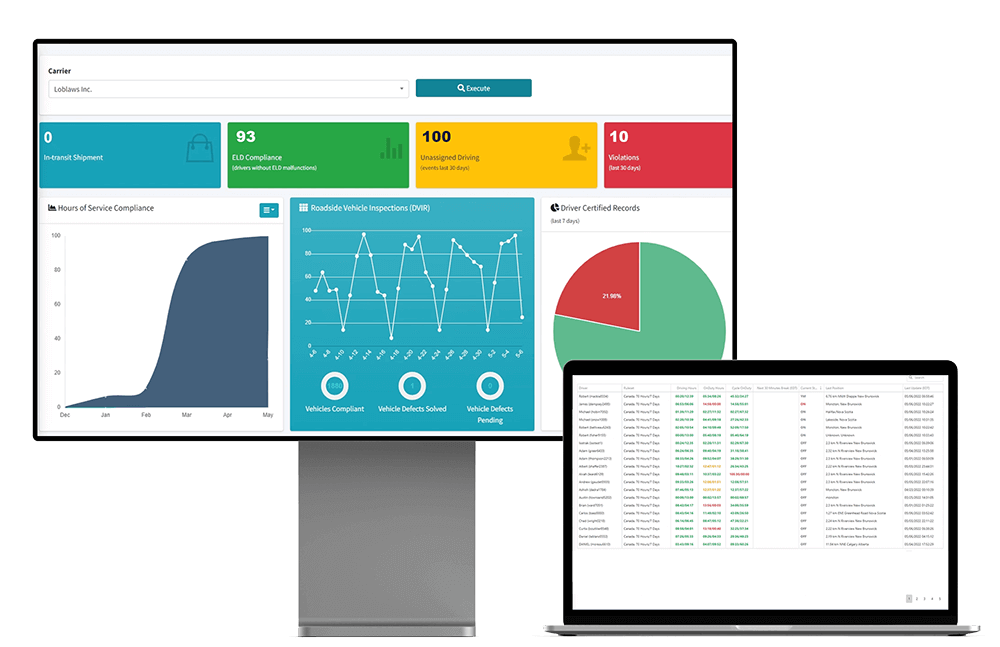What is the ELD mandate?
The ELD Mandate has been in place since 2019. Sometimes known as the ELD Final Rule, the U.S. federal government regulation requires commercial fleet operators to install and use Electronic Logging Devices (ELDs) to record vehicle and driver activity data.
Even though it’s well-established, the ELD Mandate is still the subject of confusion, debate and uncertainty. One of the areas of confusion surrounds the official enforcement date in Canada. A shortage of certification equipment has resulted in delays in implementation.
In the US, where the ELD mandate is now fully enforced, fleet operators who failed to comply in 2021 found themselves paying ELD violation fines to the DOT of up to $10,000. Canada isn’t far behind. Soon, failure to comply will not be an option.
Recently, the Canadian Council of Motor Transport Administrators (CCMTA) announced that, from January 2023, the mandate will be rigorously applied throughout the country.

In this article, we’ll will look at:
- how to protect your Compliance, Safety and Accountability (CSA) status while at the same time, maintaining the safety and security of your vehicles, drivers and other road users.
- ELD compliance requirements, specifically the need to accurately log your drivers’ Hours of Service (HOS).
- How the Isotrack solution is the perfect fit for companies wishing to comprehensively secure their ELD compliance obligations.
What is ELD?
An Electronic Logging Device (ELD) is a tablet mounted in the vehicle cab. It’s connected to the engine or to a telematics device. The device then automatically records data from the Engine Control Unit (ECU). This data includes mileage, driving time, vehicle location, driver ID and engine data. Both the driver and the fleet manager can view the data in real-time.
ELDs replace paper logs, which were inefficient and vulnerable to abuse and error. They also replace Automatic Onboard Recording Devices (AOBRDs) which can be both edited by drivers and fail to record as much data as ELDs.
What are the benefits of an ELD system?
ELDs offer numerous benefits when used alongside a subscription service from a fleet management software solution such as provided by Isotrack. With an ELD system installed, fleet managers and drivers can
- reduce the chances of driver fatigue along with the associated accidents, injuries and deaths.
- lower their companies’ insurance premiums and vehicle maintenance costs.
- accurately record their statutory Hours Of Service (HOS) records.
- manage their vehicle inspection reports, fuel usage records and receipts.
- maintain their Driver Verification and Inspection Reporting (DVIR).
- secure their International Fuel Tax Agreement (IFTA) compliance – the agreement for fuel tax collection that requires fleet owners to record fuel purchases, fuel usage and mileage.
There is also the added benefit of massively reduced HOS paperwork, saving businesses countless hours of admin.
Are all ELD’s compliant?
The short answer is ‘no’. For your ELD to be compliant, it must be tamper-resistant and be connected directly to the engine. It must also be registered with the Federal Motor Carriers Safety Administration (FMCSA) and meet all technical specifications in the ELD Rule.
Does your fleet operate across North America and cross borders? Then it’s vital that you use an ELD solution that’s recognised by
- the FMCSA
- the Minister of Transport for Canada
- the Secretaría de Comunicaciones y Transportes (SCT) for Mexico.
In Canada who is exempt from the ELD mandate?
The following vehicles are exempt in Canada from the ELD mandate – Vehicles
– operating under a specific permit issued to them by the provincial or territorial director
– operating under statutory exemptions
– subject to a rental agreement with terms lasting less than 30 days
– vehicles manufactured before the year 2000
All other commercial vehicles and drivers in Canada must use an ELD.
Using ELDs to maintain HOS rules compliance in Canada
HOS (Hours Of Service) rules were introduced to reduce incidents of drivers falling asleep at the wheel and resulting crashes, injuries and deaths.
In Canada, the limits for commercial truck drivers are –
- 13 hours of driving time from the end of the most recent period of 8 consecutive off-duty hours
- 14 hours of on-duty time from the end of the most recent 8 consecutive off-duty hours
- 70 hours over 7 consecutive days, or 120 hours over 14 consecutive days
- All drivers must take at least 24-consecutive hours of off-duty time in any 14-day period
ELDs, such as those provided by AddSecure alert drivers and fleet managers when a driver is nearing the HOS limit.

ELDs in Canada – more of a help than a hindrance!
You might feel tempted to judge the imminent introduction of the ELD mandate in Canada as burdensome federal interference. This would be a mistake. As a commercial carrier who embraces the principles of ELDs, your organization will be
- enhancing driver safety
- helping to reduce accidents and the associated costs
- increasing operational efficiency
The end result will be a healthier fleet, an enhanced reputation and a stronger bottom line.



